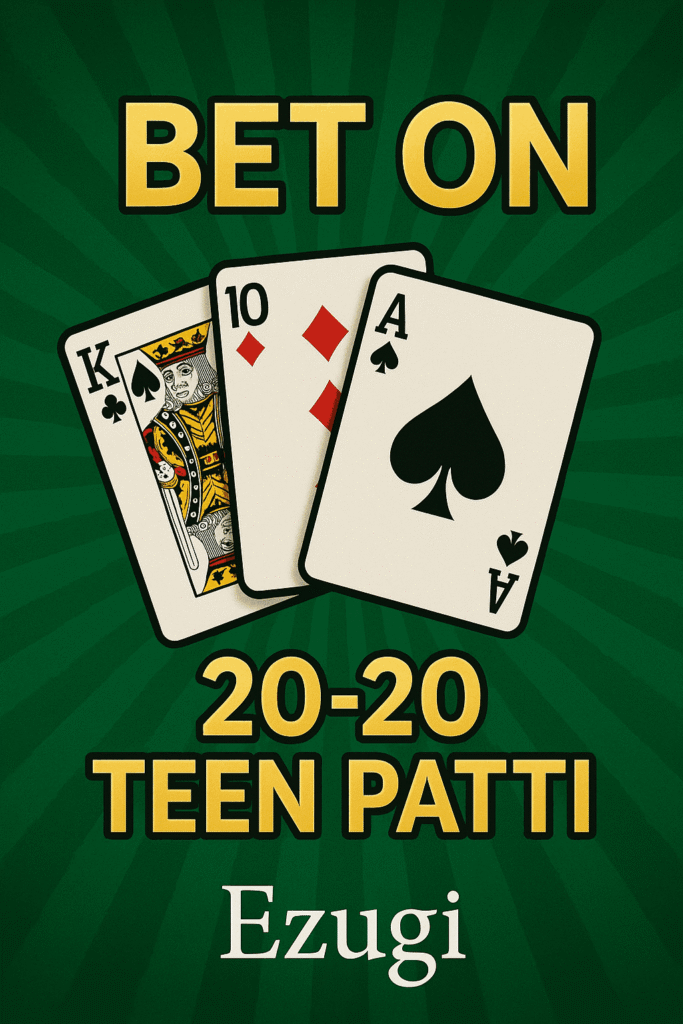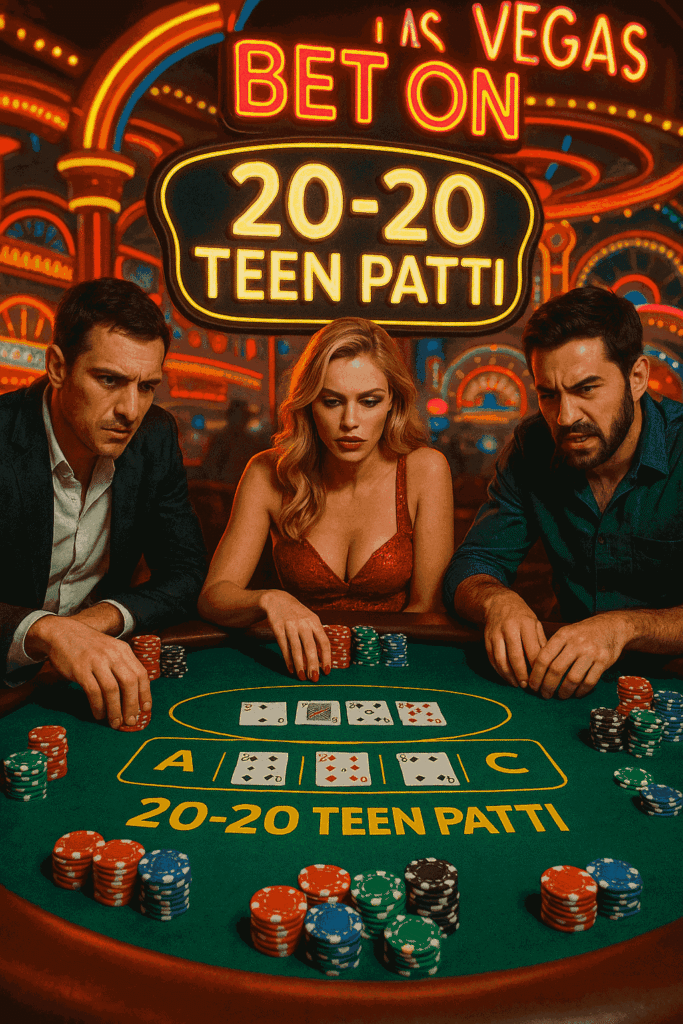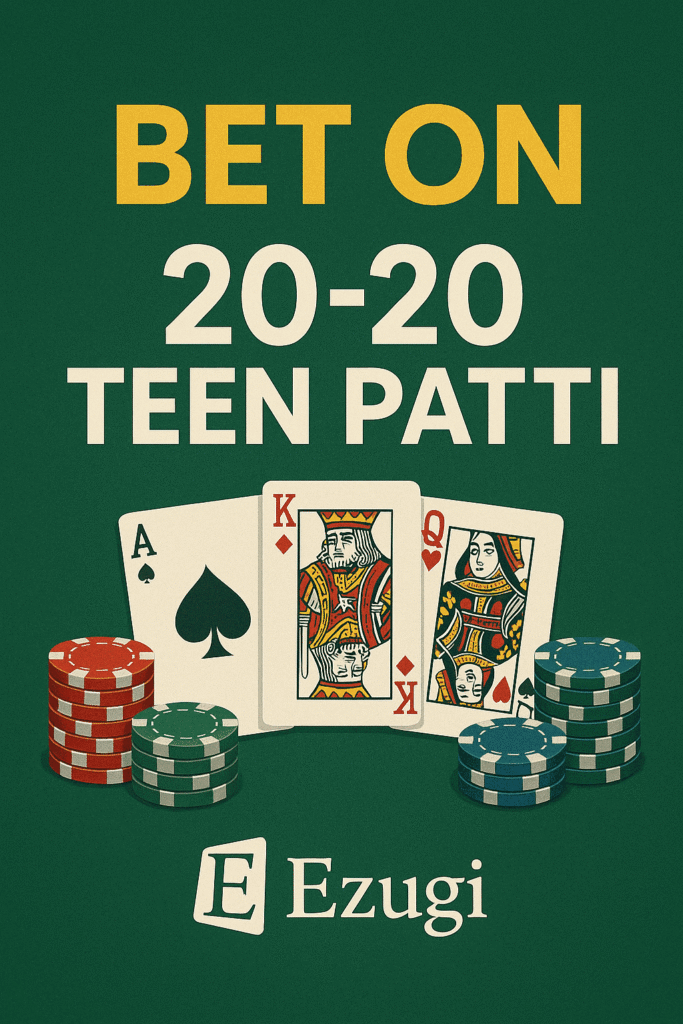This page explains how bet on teen patti and teen patti 20-20 by Ezugi work for Indian players. The setup is simple. Two positions, A and B, each get three cards. You back the side you think will win. In Bet on Teen Patti, the main line pays a fixed return when your side wins. Ties usually push on the main bet. In One Day / 20-20, the price moves during the round. You can place an early bet before any cards and then see shorter odds as more cards appear. That model rewards early risk but gives you more ways to manage positions later. Side bets like Pair+ and 3+3 exist on many tables. Some versions also offer Tie with a very high payout, but it is rare. Tables run in INR with Hindi and English hosts. Play responsibly.

What is Bet on Teen Patti? (fast A/B format for India)
Bet on Teen Patti is the quickest way to enjoy Teen Patti without playing against a dealer. There are only two seats on screen: Player A and Player B. The studio deals three cards to each. You place a bet on which side will show the stronger Teen Patti hand at showdown. The hand ranking follows standard three-card rules. The main line pays a fixed return around 0.95:1 when your side wins, and ties push on the main bet in most rule sets. That means a tied round returns your stake on the main line.
Rounds are fast. The UI is clean on mobile. You make a single prediction and let the reveal play out. Compared with “Teen Patti vs Dealer” (Ezugi’s classic game), there are no qualify rules or ante/play decisions here. You are not trying to beat a dealer. You are choosing between two opposing player hands. That simplicity is why this format is popular in India and why session results feel more stable than heavy side-bet play.
What is 20-20 / One Day Teen Patti by Ezugi? (dynamic odds)
20-20 (also called One Day Teen Patti) uses the same A vs B idea but adds dynamic odds and multiple betting windows inside each round. You can bet before the deal starts. Odds are longest at that moment, as no cards are known. After each card appears, the price adjusts. Later windows carry shorter payouts because you have more information. In many lobbies you can also add to your position or place a new bet on the opposite side in a later window. That allows in-round hedging. You can lock some profit or reduce risk if the new price makes sense.
This variant feels more like trading a round than placing a single wager. The start of the round can offer near-2x on either side. But those odds tighten quickly once a strong card shows. The naming varies by casino lobby. “One Day Teen Patti (Classic)” is a common label. The core idea stays the same. Early equals better price but higher uncertainty. Later equals more certainty but a lower return.
Round flow: card-by-card betting windows
A typical One Day/20-20 round follows a clear rhythm. You see Pre-deal, then cards land in alternating steps: A1, B1, A2, B2, A3, B3, then Showdown. At Pre-deal, both sides are blank, so the payouts are highest. When A1 appears, the odds shift. If it is a high card or a card that helps a straight or a flush, the price on A shortens. After B1, the market reacts again. This repeats after the second cards and the third cards.
Not every window is open in every studio. Some tables close certain moments to keep the pace tight. The idea does not change. Earlier windows give you more payout in exchange for less certainty. Later windows give you more certainty in exchange for less payout. Many players use a simple rhythm to avoid overthinking: consider acting every other card rather than at every step. That keeps you from chasing tiny changes and helps you weigh price versus information in a consistent way.
Bet types in Bet on / 20-20 Teen Patti (A/B, Tie, Pair+, 3+3)
The main A/B bet is the core. In Bet on Teen Patti, it pays a fixed return (about 0.95:1) when your side wins. In the dynamic game, the payout depends on when you place the bet. Ties on the main line usually push. That simple rule is one reason the format feels fair to many players.
The Tie bet exists on some tables. It carries a very high payout but hits rarely. It can swing a session hard and should be staked with care. Treat it as a small-stake punt if you play it at all.
Pair+ is a side bet on the quality of A’s or B’s own three-card hand. It pays for Pair and higher. The ladder rises through Flush, Straight, Three of a Kind, and Straight Flush. Returns vary by operator. This bet adds variance even when your main call is correct.
3+3 Bonus pays on the best five-card poker hand you can build from all six cards on the table. You are not comparing A vs B here. You are targeting five-card ranks like three-of-a-kind, straight, flush, full house, quads, straight flush. Big prizes are possible. So are long dry spells.

Payouts & RTP at a glance
Here is a fast overview of what pays what and how returns tend to compare. RTP values can vary by operator and configuration. Use these as indicative ranges and check the paytable in your lobby. As a rule, higher RTP means a lower house edge and better long-term value. Side bets usually post lower RTP than the main line.
Payouts & indicative RTP (operator may vary)
| Bet type | Variant | Typical payout | Indicative RTP / house edge | Notes |
|---|---|---|---|---|
| A/B main | Bet on Teen Patti | ~0.95:1 | ~97.39% RTP | Ties push on main bet |
| A/B main | One Day / 20-20 | Up to ~1.98:1 early; shortens later | Up to ~98.36% with sharp timing | Dynamic, in-round betting |
| Tie | 20-20 style | Very high (often quoted up to 800:1) | High house edge | Extremely rare outcome |
| Pair+ (A or B) | Both variants | ~1:1 to ~50:1 by hand strength | Lower than main line | Volatile; check table ladder |
| 3+3 Bonus | Both variants | ~7:1 to ~1000:1 (rule-dependent) | Lower than main line | Extreme variance |
Teen Patti hand rankings (3-card refresher)
Three-card rankings decide every showdown. The order is simple. Trio (three of a kind) beats everything. Pure sequence (straight flush) comes next. Then sequence (straight), then colour (flush). Pair follows, with high card at the bottom. Within the same category, compare the highest card first, then the next, then the last. A-2-3 is the lowest straight in many lobbies, so confirm the rules in your table. Suits don’t break ties. If both hands match exactly, the main line is a push where that rule applies. Read the result by first spotting obvious monsters like trips or a pure run. Then check for sequences and flushes. If nothing lands, it comes down to top card and kickers. After a few rounds you will read showdowns at a glance.
20-20 vs Bet on vs Classic Teen Patti (Ezugi)
These formats share Teen Patti DNA but feel different in play. Bet on Teen Patti is a single-decision A/B call with a fixed main payout. One Day / 20-20 uses A/B too but adds in-round betting and changing prices. Classic Teen Patti (vs dealer) puts you in a player seat with ante/play decisions and dealer qualify rules. Use the table below to spot the right fit for your style.
Variant comparison (quick view)
| Feature | Bet on Teen Patti | One Day / 20-20 (Ezugi) | Classic Teen Patti (vs dealer) |
|---|---|---|---|
| Format | A vs B, fixed main line | A vs B, dynamic odds | Player vs dealer |
| Betting windows | Single, pre-deal | Multiple, card-by-card | Ante/Play flow |
| Main payout | ~0.95:1 on winner | Up to ~1.98:1 early; drops later | 1:1 on Play when dealer qualifies |
| Side bets | Often Pair+, 3+3 | Often Pair+, 3+3 | Pair+, 3+3 common |
| Tie bet | Sometimes offered | Sometimes offered; very high payout | Not typical |
| Typical RTP (main) | ~97.39% | Up to ~98.36% with timing | Varies by rules; lower with side bets |
| Pace & volatility | Fast, moderate swings | Fast, can hedge mid-round | Moderate, depends on qualify |
Variance & bankroll in A/B Teen Patti
The main A/B line gives the steadiest ride in both formats. You win a modest fixed or variable return often enough to keep the graph smoother than with side bets. Tie and 3+3 add heavy variance. They can lift a session fast but can also drain a stack during dry spells. If you use the dynamic table, hedging can help manage swings. For example, you back A pre-deal and later take a small position on B after A1/B1 if the price has moved too far. That reduces downside at the cost of some upside. The key is to hedge only when the new price makes sense. Hedging at random often locks in mediocrity.
Set your bankroll in INR with simple rules. Fixed-stake per round or a small percent of your session roll. Keep side bets tiny compared to the main line. Decide a stop-loss and a profit lock level before you start. The goal is not to predict every round. The goal is to avoid one bad streak wiping your session.

Betting tips for Bet on & 20-20 Teen Patti (India)
Quick, practical tips:
- Prefer the main A/B line for most of your action.
- In 20-20, take early prices only when the spot looks strong; otherwise wait for the next window.
- Think in price vs information: if the price is too short after a reveal, pass.
- Treat Tie as a tiny side shot, if at all.
- Use session limits and a simple stake cap in INR.
- Don’t chase after a loss; reset and wait for a clean spot.
- Hedge only when the new odds lock value, not out of fear.
- Track a few rounds before joining to read the table rhythm.
Common mistakes to avoid
What to skip:
- Dumping big stakes into Pair+ or 3+3 every round.
- Firing the Tie bet repeatedly.
- Assuming fixed ~0.95:1 on the main line in 20-20 (it moves).
- Doubling stakes after losses to “catch up.”
- Ignoring push rules on tied main results.
- Hedging so much that you erase any edge.
Tables, limits, languages & mobile UX (India)
Most Indian-facing lobbies set INR minimums low enough for casual play and post clear maximums for high-rollers. Dealers or presenters speak Hindi and English depending on the studio and time of day. The portrait UI is friendly on phones. Chips, bet slips, and cash-out confirmations are clean and quick. Many lobbies show session counters for hands dealt and recent results. Use those only as context, not as a signal of what must happen next. Payment and account flows vary by operator. Expect UPI and common local methods for deposits and withdrawals where allowed. Compare providers in your cluster before you pick a table. Some studios favor tighter windows and faster pacing; others give longer decision time.
FAQ
1) Is “20-20 Teen Patti” the same as “Bet on Teen Patti”?
No. Both use A vs B, but Bet on Teen Patti pays a fixed main return. 20-20 (One Day) changes the price across the round.
2) What does the main bet pay?
In Bet on Teen Patti, about 0.95:1 on the winner, with ties usually pushing. In 20-20, the early window can be near 2x and then drops as cards appear.
3) Are side bets worth it?
They are fun and volatile. Expect lower RTP than the main line. Keep stakes small if you use them.
4) How much does the Tie pay?
Very high in some rules (often quoted up to hundreds to one). It is extremely rare. Stake tiny or skip.
5) Can I bet both sides in the same round?
On dynamic tables, you can often add a later bet for hedging. Check the on-screen rules and window prompts.
6) What’s the RTP?
The main line in Bet on Teen Patti is often around 97%+. With sharp timing, the main line in 20-20 can post higher headline RTP. Operator settings vary.
7) Is this okay for beginners?
Yes. Start with the main A/B line, avoid side bets at first, and set a strict session limit.